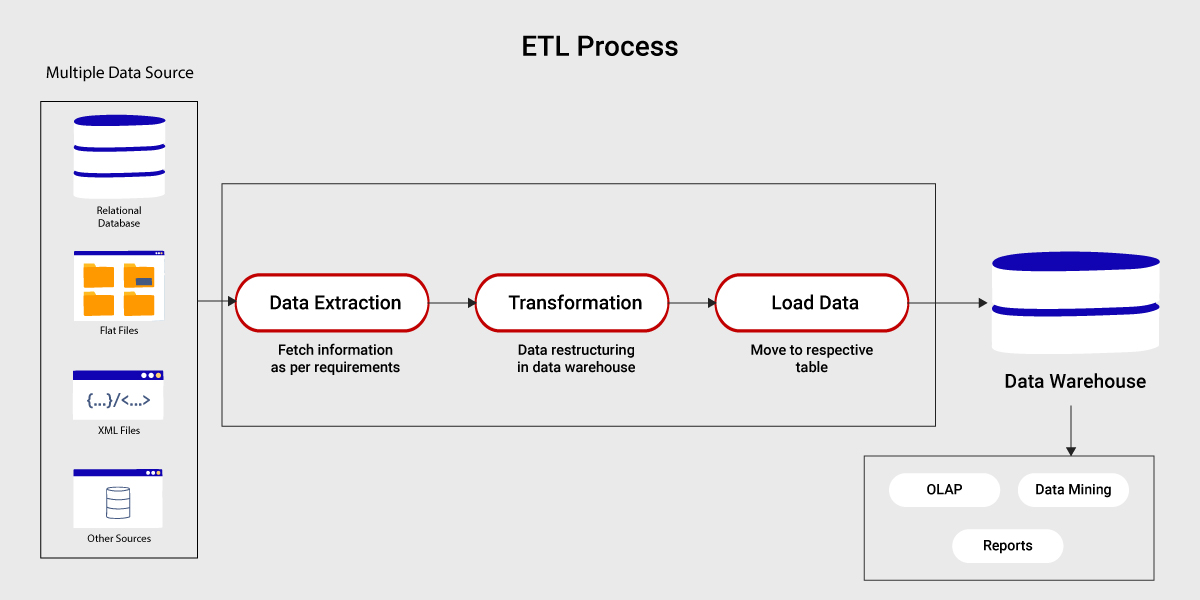You’ve probably come across the phrase – “data is the new oil”. Well, believe it or not it is. With the amount of data generated by organizations day in and day out, it is becoming crucial for businesses to process it the right way since the amount (volume) and variety of raw data are increasing rapidly. And, the world of data management is evolving rapidly with relevant technologies and tools.
Since the last decade, the Extract Transform Load (ETL) process has become fruitful amongst data-driven businesses to ensure smooth business data exchange. It is especially true if the plan to extract and transform information is from several sources before loading it into a centralized repository. If you’re wondering how ETL solutions can help your business boost to a new era of growth, then this article will help you understand the reasons why it is gaining traction across the world.
What is ETL Process?
It is the process by which data is extracted from data sources – like existing databases and legacy systems, cloud, hybrid & on-premises environments, mobile devices & apps, CRM systems, and moved to a central host. ETL, which primarily means Extract, Transform & Load covers – the transportation of data and overlap between each of these stages.
Why is ETL Important in Data Warehouse?
The importance of ETL in any enterprise is directly related to their reliance on data warehousing. ETL tools capture, collate, read, and transport massive volumes of raw data from disparate sources. They load this data onto a single data store for easy access and processing. To make this raw, unstructured data meaningful, ETL tools process the data with operations like organizing, classifying, combining, reformatting, screening, and merging. Finally, these tools make use of graphical interfaces to produce faster results than conventional methods of migrating data via hand-coded data pipelines.
ETL tools break down data silos for Data Scientists who can easily access and quickly analyze data. To sum it up, ETL tools are your first, crucial step in the data warehousing process to turn raw unstructured data into business intelligence that lets you make informed decisions faster.
ETL Process Overview

Three steps govern the entire process and are applied to diverse data sources to transform raw data into crucial insights.
Extraction
Organizing data comes secondary but what takes the lead is the pulling of data from an array of relevant sources.
- This is where all the required data is prepared for integration. Interestingly, your data can come from anywhere – whether it means on-premises data, cloud data warehouses, structured and unstructured files, marketing automation platforms and more.
- Upon consolidation of data, you would notice that all the information is dated & structured in various formats.
- This is also the stage that prepares the data transformation with a certain level of consistency before it is fed into the system and prepared for conversion. However, it is also important for you to note that the complexity of this step can vary depending on a variety of factors like data volume, disparate data sources & data types.
Transformation
During this phase, the data extracted from diverse sources as accumulated information is converted, reformatted & cleansed before it is ready to be fed into a specific database.
- The application of a series of functions along with a set of rules ensures the data conversion takes place into various formats that align with the schema requirements.
- To determine the level of operation required for ETL transformation, you need to have a clear idea about the information that’s being extracted in line with your specific business needs. Do note that this stage also includes validation and rejection of data. Additionally, if the quality of your data is optimal, the transformation would not need to happen on a larger scale.
Here’s a breakdown of the steps involved in this stage:
- Data conversion as per business needs
- Reformatting of data to a standard format for compatibility
- Elimination of irrelevant data from datasets
- Sorting & filtering of data
- Elimination of duplicated information
- Translation where applicable
Loading
Now comes the part where the extracted and transformed datasets are loaded into the specific database. This can be done in two ways.
- The first one is an SQL routine. It involves the manual insertion of every single record of the target database.
- The full load process is divided into two types: full loading and incremental loading.
- Full loading process happens only at the first data loading task to populate the destination – it happens with all the available data.
- Post that, the incremental loading enables loading the updated data
- Also, it is important to note that the increments could be;
- Streaming increments – to handle small volumes of data with regular updates
- Batch increments – to handle a large volume of data
Importance of ETL in an Organization
There is an array of reasons for an organization to make the most of an ETL process. Here are some of the most significant ones based on our experience :
Better Performance
The ETL infrastructure is such that it helps you adopt new technologies to help you gain a competitive edge. This will also help you simplify the data processes. Additionally, many tools help with improving the performance that comes as an add-on for the ETL process.
Enhanced Business Intelligence
ETL tools enable data access by simplifying the process of extracting, transforming & loading. It helps businesses make faster & well-informed decisions that are based on data-driven facts. The technology is such that it helps you access data with ease. What this means for you is the ease for business leaders to retrieve information based on their specific needs and make decisions accordingly.
Higher & Improved ROI
The management of tons of data is a mammoth task. And not having appropriate tools & processes will only bring in more misery! Think about the unproductive use of resources & the lack of intelligent insights that would worry you all the more. ETL tools & processes help businesses to save costs and thereby, generate higher revenues.
Top ETL Tools
Talend
As the top ETL tool, it can connect with absolutely any data warehouse. Its interactive user interface makes it an attractive option for businesses that want to transform data & create custom workflows.
- A code generation approach requires you to make every change using logic.
- Ideal for businesses that have tech-savvy resources or those that have an extended arm of IT professionals. While that is the case, it sure has some features that would wow you, like hybrid & multi-cloud operations that support data governance needs. Further, you can also manage the entire data lifecycle, without letting data quality take a hit!
AWS Glue
Part of the Amazon ecosystem, it works well for organizations that rely on Amazon data warehouses and other services. It can automatically generate scripts in Python and Scala to create efficient ETL processes.
- Performs an array of activities on your data, which includes data preparation, data ingestion, data transformation, through to building a data catalog.
- Meeting all the requirements for data ingestion, helps you analyze your data effectively. This data can then be easily utilized instead of waiting for months! Its code-based and visual interfaces make data integration way easier. These features make it easy for users to look for relevant data.
Azure Data Factory
This tool is also known as a serverless, fully managed data integration service. With Azure data factory at your disposal, you can seamlessly appropriately build ETL processes without requiring coding knowledge. This will help you transfer integrated data to Azure synapse analytics to uncover crucial insights that will give your business an edge.
ETL Use Cases
Data strategies are no easy feat. And ETL tools make it easy for you to transform large amounts of data into actionable insights. Here are a few enterprise-level use cases;
Partner Onboarding & Data Management
With businesses onboarding new partners and vendors every year, IT teams are often tasked to code custom workflows to create complex data pipelines that ensure seamless information exchange.
An automated ETL solution supports;
- Establishing self-operating and self-regulatory onboarding processes
- On-time delivery of insights for a beneficial collaboration
- Reduction in onboarding time to hours instead of days
Self Service Data Access
With hundreds of enterprise systems operating at full volume, the data is scattered across the board. For business users, the reliance on the IT departments for relevant, accurate information for analysis and reporting is at an all-time high.
An automated ETL solution supports;
- Complete data democracy for business users
- Simplifying and breaking down information silos
- Greater business agility and higher productivity
Why Choose Rishabh?
Data integration and ETL development are at the very core of our analytics focus. With a diverse technology stack, we transform the way the organization’s raw data is analyzed during their ETL journey. We help serve the needs of all our ETL clients that set them apart in the market. We’ve worked with an array of enterprise clients to assist them with their digitalization initiatives. As Microsoft Gold Partner with competency in data analytics, we demonstrate the technical capabilities to create robust business intelligence solutions.
Further, we do realize the importance to connect and centralize information from multiple data sources to meet the rapidly changing needs of the business units.
We offer end-to-end ETL solutions and services that cover understanding all the data sources, ingesting them, managing them across the lifecycle and ensuring it serves a decision-making purpose. Rishabh has a strong experience with a successful track record of implementing solutions using SQL and Azure Data Factory. Further, we can work across all areas of ETL implementation, from software selection to implementation planning and report writing.
With our help, businesses can significantly cut on data costs and boost process performance. Our familiarity with tools from open source & the enterprise stack, along with a thorough understanding of legacy and cloud stack makes us a preferred partner for custom solution development. Explore our data engineering services capability with ETL and ELT to learn how we can help you integrate pipelines, data warehouses, BI tools & governance processes.
Our ETL Use Case
Cloud-Based Data Warehouse System
A US-based hospitality giant was on the lookout for a technology partner to integrate data from diverse business apps like RMS, Cognito forms, Opera & more onto a single platform.
Upon careful analysis of their existing operations, we proposed to develop a cloud-based data warehouse solution that would serve as a powerful repository for data visualization & reporting. Our detailed scope for end-to-end ETL development covered – detailed design ( with routines, packages & schedules), implementation & testing. This was with the application of ETL business rules including the creation of ETL packages to create a Data Warehouse.
Here’s what the developed solution resulted in:
- 50% increase in workflow efficiency
- 99% accuracy of business understanding on-the-go
- Improved decision-making with reporting & visualization
Final Words
Every business in the world today, irrespective of its size is thriving on a vast amount of data. From gaining a 360-degree of customer data to streamline partner onboarding, ETL offers a host of valuable uses. But without a knowledgeable team and powerful tools, this information cannot be cleaned up or made accessible for analysis.
To put it simply, robust ETL tools and processes act as controllers for BI and Data Visualization. This is because they control the flow of data between myriad source systems and applications. Therefore, as data management becomes more complex, the data integration tools also need to change while keeping up the pace.











 30 Min
30 Min


